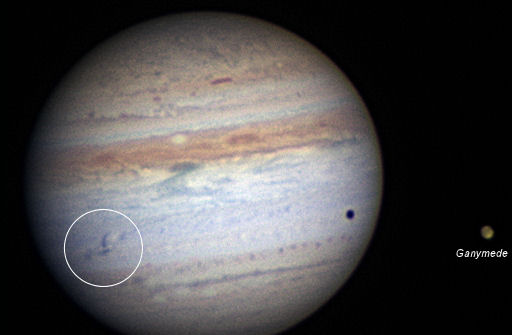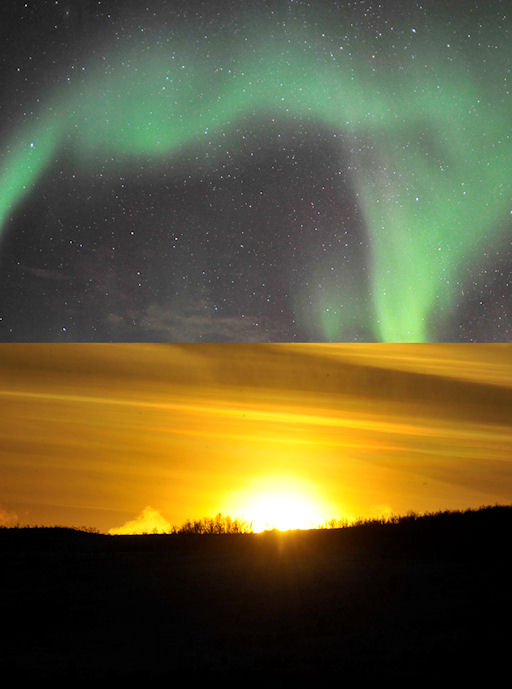LEONID METEOR SHOWER: The annual Leonid meteor shower peaks this year on Nov. 17th when Earth passes through a thicket of debris from Comet Tempel-Tuttle. Earth is expected to miss the densest swarms of comet dust, making this an off-year for Leonids with a maximum of only 20 meteors per hour. The best time to look is during the dark hours before sunrise on Wednesday.
BONUS: Turn up the volume and play this movie of an early Leonid recorded on Nov. 14th by amateur astronomer Thomas Ashcraft in New Mexico. The soundtrack is a forward scatter meteor echo--that is, a radio signal from a distant TV transmitter bouncing off the meteor's ionized trail. See? Even one Leonid can be enough.
REVIVAL ON JUPITER: Think of the turmoil at the sea surface just before a massive submarine emerges from depth. Something like that is happening on Jupiter. A turbulent plume is breaking through the giant planet's cloudtops in the south equatorial zone, heralding the emergence of ... what? Scroll past this Nov. 14th photo from astrophotographer Paul Haese of Glenalta, South Australia for further discussion:

The plume, circled in Haese's photo and known to astronomers as the "SEB Revival Spot," is a sign that Jupiter's South Equatorial Belt (SEB) is about to return. The great brown belt disappeared earlier this year, leaving Jupiter without one of its signature stripes. No one knows where the SEB went, although some researchers have speculated that it sank beneath high altitude clouds and might now be bobbing back to the top.
Christopher Go of the Philippines first noticed the Revival Spot on Nov. 9th. At first it was small and white and required careful astrophotography to detect. Only five days later, it is expanding rapidly and darkening; soon, it could become visible to novices in the eyepieces of backyard telescopes. Stay tuned for updates.
more images: from Brian Combs of Buena Vista, GA; from John Nassr of Baguio, Philippines; from David Kolb of Lawrence, KS
LAST SUNRISE: "Goodbye Sun!" declares Fredrik Broms of Kvaløya, Norway. "Yesterday, the sun climbed over the mountains for the last time of the year here in northern Norway, not to return until next year. Instead we enter the polar darkness, which is not necessarily that dark." Consider the following:

"I created this composite from photos taken at noon and midnight on the same day, Nov. 15th," explains Broms. "Green replaces yellow!"
It could get even greener. A high-speed solar wind stream is buffeting Earth's magnetic field and sparking geomagnetic storms around the Arctic Circle. NOAA forecasters estimate a 50% chance of high-latitude geomagnetic activity during the next 24 hours.
October 2010 Aurora Gallery
[previous Octobers: 2009, 2008, 2007, 2006, 2004, 2003, 2002, 2001]
Potentially Hazardous Asteroids (
PHAs) are space rocks larger than approximately 100m that can come closer to Earth than 0.05 AU. None of the known PHAs is on a collision course with our planet, although astronomers are finding
new ones all the time.
On November 16, 2010 there were 1164 potentially hazardous asteroids.
Notes: LD means "Lunar Distance." 1 LD = 384,401 km, the distance between Earth and the Moon. 1 LD also equals 0.00256 AU. MAG is the visual magnitude of the asteroid on the date of closest approach. | | The official U.S. government space weather bureau |
| | The first place to look for information about sundogs, pillars, rainbows and related phenomena. |
| | Researchers call it a "Hubble for the sun." SDO is the most advanced solar observatory ever. |
| | 3D views of the sun from NASA's Solar and Terrestrial Relations Observatory |
| | Realtime and archival images of the Sun from SOHO. |
| | from the NOAA Space Environment Center |
| | the underlying science of space weather |

